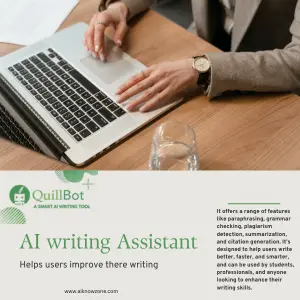
AI Text Detector
Dive into our review of AI Text Detector, exploring its features, accuracy, and real-world applications for detecting AI-generated content.
Description
Is AI Text Detector the Real Deal? A Hands-On Review
Alright, folks, let’s get real about AI. It’s everywhere, and sometimes it’s hard to tell what’s human and what’s machine. That’s where an AI Text Detector comes in handy! I recently took a deep dive into the world of AI Text Detectors, specifically focusing on tools designed to sniff out whether a piece of writing was crafted by a human or spat out by an AI like ChatGPT, GPT-4, or some other language model. My goal? To see if these detectors are actually worth their salt. Is it truly possible to catch AI-generated content with a reasonable degree of certainty? Are we talking about a future where originality matters again, or are we just chasing technological ghosts? I have been hearing about these detectors all over, and the thought of being able to check whether an essay from my child was written by AI is really intriguing! The information surrounding the topic can be confusing; some sources say they have high accuracy while others claim their performance is abysmal, so let’s take a look!
Key Features and Benefits of AI Text Detector
So, what can you actually *do* with an AI Text Detector? Well, after playing around with a few of them, here’s the lowdown on the main features and how they help:
- AI Content Detection: This is the core function, of course! The tool analyzes your text to determine the likelihood it was generated by AI. Some tools, like ai-detector.ai, even claim impressive accuracy rates, like 98%. Others may give a percentage or a scale.
- Multi-Language Support: Many AI Text Detectors, such as QuillBot’s AI Detector and others, now support multiple languages, including English, Spanish, German, French, and Dutch. This is super useful if you’re dealing with content from around the globe. I tried it with Spanish and got some surprising results.
- Detailed Analysis: Some detectors provide more than just a “human” or “AI” label. They offer insights into the linguistic patterns and characteristics that suggest AI involvement. Copyleaks AI Content Detector, for example, gives you a detailed analysis of the text. It’s like having a digital forensics team for your writing!
- Integration & Accessibility: Several tools offer convenient integrations. Textdetector.ai, for example, has apps that make it easy to scan text via your phone or even use an Action Extension to check text from anywhere on your device.
How It Works (The Easy Version)
Using an AI Text Detector is usually pretty straightforward. You generally just copy and paste your text into a designated box on the website or app. Then, you hit the “Detect AI” button (or something similar), and the tool gets to work. Some tools might ask you to select the language of the text to improve accuracy. According to QuillBot, you ideally want at least 80 words for the analysis to be effective. Once it’s done crunching the numbers, you’ll get a report indicating the likelihood that the content was AI-generated. This report might include highlighted sections of text that the tool flags as potentially AI-written, giving you a better understanding of why it made its determination. This can be useful if you are a teacher and are looking to provide concrete proof that a submission was created by AI.
Real-World Use Cases for AI Text Detector
Here are some ways you might actually use an AI Text Detector in your day-to-day life:
- Checking Student Work: As a parent, I might use it to get a sense of whether my kid wrote their essay themselves. Teachers can use these tools to check if students are submitting AI-generated work, helping to maintain academic integrity.
- Verifying Content Authenticity: If I am paying for blog posts or articles, this could be very helpful! If you’re hiring freelance writers, you can use an AI Text Detector to ensure the content you’re paying for is original and human-written.
- Reviewing Important Documents: Legal documents, contracts, or important emails could be checked to ensure they were written by a person to ensure that the language is actually something a person would say. I can make sure nothing sounds too robot-like and that it is authentic.
Pros of AI Text Detector
- Relatively easy to use.
- Offers quick insights into potential AI-generated content.
- Some tools provide detailed analysis to support their findings.
- Available across multiple platforms (web, mobile apps, extensions).
Cons of using AI Text Detector
- Not always 100% accurate; false positives and negatives can occur.
- Accuracy can be affected by the length and complexity of the text.
- Effectiveness depends on the training data used by the detector; newer AI models may evade detection.
AI Text Detector Pricing
Pricing for AI Text Detectors varies widely. Some tools, like aitextdetector.net and ai-detector.net, offer free basic detection services. Others, like Originality.AI, operate on a paid subscription model, offering more robust features and higher accuracy. It’s important to compare the features and pricing of different tools to find one that fits your needs and budget. Some providers offer a free tier with limitations, while others provide free trials for their premium features, allowing you to test before committing.
Conclusion
So, is an AI Text Detector worth it? Well, it depends. If you need absolute certainty, no AI Text Detector is perfect. These tools can be helpful in flagging potential AI-generated content, but they shouldn’t be the only factor in your decision-making process. They’re best used as a starting point for further investigation. Educators, content creators, and anyone concerned about plagiarism or authenticity can benefit from using them. Just remember to interpret the results with a grain of salt and always double-check the information.





Reviews
There are no reviews yet.